|
TEXTILE TRAVELS : THAILAND AND LAOS
Kathleen Forance Johnson
November
29, 1998, Taipei
On February 4
of this year I wrote "We have just returned from a two-week trip
through Northern Thailand and neighboring Laos. I might just as well
say, "I’ve just been to weaver’s heaven and back again!"
Within the area encompassed by the old Lan Na kingdom centered in
Chiang Mai, Thailand, and extending into Northern Laos to its ancient
capitol in Luang Prabang, a large number of diverse ethnic groups
are found. Many have extremely old, rich and complex weaving traditions,
and some maintain their vitality to this day in spite of modern economic
and political disruptions. Over the borders in adjacent territories
of Burma and of China’s Yunnan Province, as well as in Northeastern
Thailand and Southern Laos, related ethnic groups and similar weaving
technology and decorative traditions exist. The
region’s rivers, especially the Mekong, with its fertile plains,
encouraged the development of agricultural communities and the movement
of goods and people along a southern spur of the ancient trade routes
which extended all the way from Persia to Canton and over which fibers,
textiles and cultural ideas traveled. Having become familiar with
India’s handloom textiles during the seven years I lived and
worked there, I found myself often making mental comparisons and finding
points of commonality and divergence. After all, Assam and other Indian
states along the Burma border are not so far away.
As a hand weaver
and collector of textiles, I found traveling through this region fascinating
and was nearly overwhelmed by the variety of handloom textiles on
display for sale in the local markets of Chiang Mai, Vientiane and
Luang Prabang. Added to this is the current extremely favorable dollar
exchange rate which makes this a prime time for "textile junkies"
to be traveling and collecting a good range of reasonably-priced textiles.
Antique textiles are more expensive but even they are half the price
they would have been six months ago. With some pre-planning and willingness
to adjust to variable local accommodations, a trip to these textile
centers can be undertaken on a slim budget.
The primary objective
of our trip was to re-visit the little town in Northern Thailand,
near Chiang Mai, where my husband had taught English as a Peace Corps
Volunteer thirty-five years ago. The weaving quest and general sightseeing
formed a compatible sub-set. While my husband was planning where to
go and what to see, I was trying to digest the contents of the few
available books in English about the weaving styles and techniques
we were likely to encounter. At the same time, I was able to talk
with U. S. Government representatives about conditions in the region
and to learn about development projects that involve various aspects
of textile production. We also met two remarkable expatriate weavers
who have been working in the region to collect, document, reproduce,
re-design and market handloom textiles of the region to world markets.
At a certain
point fairly early on in this journey, I realized that I would only
be able to get a "quick take" on the complexities of the
weaving we were seeing; to formulate a few basic concepts and amass
a body of vivid impressions. My main conclusions are as follows: there
seem to be historically two major categories of traditional handloom
textiles. The first includes those produced in villages and individual
households for domestic and local use and limited trade using indigenous
materials, styles, motifs and technologies.
The second features
opulent "palace textiles" which were professionally produced
for wealthy patrons, including the aristocracy, or for special occasions.
These often included outright importation of foreign materials and
techniques or modifications and adaptations of foreign textiles. They
often incorporated expensive imported materials, techniques and motifs.
Some design motifs
came by way of the spread of Buddhism; others are more animistic,
having protective or ceremonial significance, which may date back
to pre-historic sources.
The symbols found
on the bronze drums of the Dongson culture (in what is now part of
Vietnam) are often cited as early sources for some textile designs
(although it seems equally likely to me that the drum designs reproduced
earlier textile designs or are related to textile -impressed designs
on early pottery). Other designs seem to be more local in origin,
possibly having totemic or protective significance or having "power
qualities" which are imparted to the textile.
I was particularly
interested in what has been called the "hook design," which
apparently is found on the bronze drums and in many other forms and
permutations throughout Southeast Asia. It starts out as an "S"
hook, which may have been a snake "ancestor" sign but equally
well transforms into the mythical Hindu snake guardian spirit called
a "naga", which was pressed into service by Buddhism
Displays of rank
or social standing, and of ethnic identity seem to play a part in
both of the above categories, both in the past and present traditional
context. Furthermore, specialized textiles were and are woven for
a variety of functions, both secular and sacred. On the on hand, you
have everyday clothing, household furnishings and in Thailand multipurpose
cloths. On the other, there are those textiles which were/are specifically
woven for festive and ceremonial occasions, including cloth offerings
to the temple, through which the donor earns religious merit. Some
traditional weavers are now finding new markets for their beautiful
textiles and are able to earn respectable cash incomes for their work.
In Laos, I was told that a skilled weaver could earn three to five
times what the average agricultural worker could (which is still under
$200 per month instead of just $30.)
The most frequently
used fibers are cotton and silk. In Thailand, sericulture enjoys royal
patronage. Throughout her reign, Her Majesty Queen Sirikit has been
active in promoting Thai silk and silk weaving as a national industry
and source of national pride. What was once almost a lost art, has
now been taken to new heights of sophistication;
In the village
setting, most weaving activities take place in the space under the
house platforms where houses are built on stilts, or under a side
sheltered work area in the case of houses built on the ground. Women
and girls do most of the weaving, and education for this kind of work
starts early, from the age of eight to ten and onward. The most common
kind of loom is a frame loom with a hanging beater with split bamboo
reed, bamboo heddle sticks with string heddles, heavy wooden shed
sword, bamboo shed sticks or the string vertical heddle system for
executing complicated continuous and discontinuous weft inlays. I
bought a whole loom outfit minus the wooden frame in Vientiane for
$3.00. It’s an amazingly simple piece of equipment, just sticks
and strings, but wonderfully efficient in the hands of a skilled weaver.
. Beautiful weft ikat patterns are woven as well as continuous and
discontinuous weft patterns and tapestry inlays. I was told that warp
ikats are not frequently used in this area. Patterns using a supplementary
warp technique are used but we did not happen to see any in process.
I found it interesting that most of the looms we came across did not
have a rotating back beam for winding on the warp. It was either wound
onto a board and anchored at the back of the loom, or wound under
the back beam and up into the part of the frame and advanced manually
from one cross beam to the next. Complex patterns of supplementary
weft, tapestry technique and supplementary warp are controlled with
an ingenious system of pattern-shed sticks and the horizontal heddle
system. Each stick controls one shot of the pattern. The stick (or
string, as the case may be) is brought down through the system and
the required set of warps is raised. After the shot is thrown, the
vertical heddle shed is kept open and the stick removed from the upper
position and into the open space in the string heddles below the warp.
Here it is safely kept in order until the next time the pattern is
to be repeated. Then the process is reversed and the pattern shed
is opened, woven, and the stick taken out and put in the string heddles
above the warp. This arrangement, while quite simple, is very timesaving
and handy for saving and trading patterns.
I was told that
the more well-to-do weavers can pay to have a specialist come in and
set up their vertical string heddle system as this part is very technical
and time consuming. In India this was called "naksha bandan",
literally "to tie the pattern ".
Back strap looms
are in use in some of he Thai hill tribe villages we visited. In this
settlement there were only a few older women at home weaving simple
traditional cloths for domestic use and a couple of younger women
weaving souvenir type bags and belts for sale to tourists. They use
a type of backstrap loom with their warp tied to a railing on the
"front porch" of their houses which are often built on stilts.
The colorfully banded tube skirt is a basic item of clothing for the
women of these communities. In some other places we saw a few women
wearing inexpensive sarong prints, but they still seem to be in a
minority. Weavers
in Development: We
were fortunate to be able to meet with Carol Cassidy at her internationally
famous weaving workshop in Vientiane, Laos and with Patricia Naeena
at her textile studio in Chiang Mai, Thailand. Both are extremely
knowledgeable, doing very interesting and worthwhile work, but each
is approaching the social, educational, artistic and commercial development
of weaving from different angles. The region of Northern Thailand
and Laos we are talking about includes "the Golden Triangle,"
one of the worlds’s most famous opium poppy growing areas. Efforts
are being made to institute crop substitution and re-locate poppy
growing tribes out of the higher mountain areas where their slash
and burn agriculture takes a terrible toll on the environment. United
States governmental agencies and non-governmental organizations are
involved in various aspects of some of these projects. Encouraging
sericulture and weaving as an income producing cottage industry is
having great success in some of the model projects we heard about
precisely because it puts economic power into the hands of women who
do most of the work involved and they know it is good for their families.
Given the proper
circumstances, a skilled hand weaver can earn three to five times
the average income of an ordinary agricultural worker, even more than
they would have earned raising poppies, and without the negative consequences
of the opium trade. I was told that such projects are meeting with
great success because the women love it. It is the women who have
grown the poppies and the women who grow the silk worms and weave
the cloth. They know that the poppies ruin the environment and that
the fields have to be moved every two years, with more slash and burning
of the forests every time they move. Furthermore, working in the poppy
fields takes them far away from homes and children during the day.
With sericulture and weaving, they can stay closer to home, care for
their families, earn some cash and avoid the danger of having their
men folk become addicts.
Much is made
of the beauty of the natural dyes used in the textiles of the past.
However, a quick look at some of the brighter than bright colors which
have crept into otherwise rustic textiles is enough to convince me
that synthetic dyes have made it into the farthest reaches of the
weaving hinterlands. Nevertheless, a number of natural dyestuffs are
still available and are apparently used on a limited scale. Sappan
wood, Stick Lac, Jack fruit wood, Turmeric root, Ermarginate wood,
Annato seeds and Ebony fruit are some of the dyestuffs derived from
local natural resources used in these areas. How many weavers actually
have the time to gather and process them instead of buying synthetics
in the market, is another question.
Patricia Chessman
Naenna is a remarkable Englishwoman now living in Chiang Mai, Thailand
and before that in Laos for a number of years. She has made an in-depth
study of historic and contemporary textiles of Thailand and Laos,
and is an avid collector and documentor, and is working to help preserve
traditional weaving forms and skills through inspiration and marketing.
She has established a weaver’s co-operative and she works with
this community of weavers and she helps to support its members through
the sale of their products in her "Textile Gallery".
She is also knowledgeable
about Lao textiles and spent a number of years there before settling
in Chiang Mai. . She genuinely loves these textiles and is a much
repeated and published authority. She displays a special love of the
natural dyed fabric.
She has made
a comprehensive collection of representative antique textiles and
works with weavers in about twenty villages to reproduce, recombine
or recompose some of the old designs and textiles. She does some of
the natural dying of yarns, particularly indigo, herself then distributes
them to weavers in her women’ co-operative, "Weavers for
the Environment". Their finished products are returned to her
for sale at her showroom/workshop. The weavers take into consideration
her suggestions and preferences, their own inclinations and traditions
and then return the finished pieces to her for sale.
The beneficial
effect of the marginal tinkering she does with color scheme, composition
and design and motif selection is immediately apparent when you leave
her textile gallery and go to the local markets. Here the senses can
easily be saturated with the amount of raw color and the sheer volume
of surface decoration in pieces offered for sale. Some pre-selection
and supervision seems a very good service in this case. All of her
pieces, both antique and new, are beautifully designed, well finished
and very affordable. She continues to go out on collecting trips and
has also recently taken textile tour groups out into the more remote
villages of weaving interest.
Carol Cassidy
is an excellent weaver, an outstanding designer, and a dedicated and
energetic worker. She has also become a successful businesswoman in
a climate, which is not necessarily "business friendly"
in Laos. After years of struggling to survive, she has
succeeded, and her hand-dyed and hand-woven silk designs, based on
modified and refined traditional Lao weaving motifs and techniques,
have finally taken off.Her work has recently been shown in a major
exhibition at the Fashion Institute of Technology in New York, and
received media coverage in the International Herald Tribune, the New
York Times and CNN. She has been credited with " single-handedly"
rescuing traditional Lao weaving techniques and designs from obscurity,
if not extinction.
However much
this overstates the case, she has certainly put Lao weaving on the
map in world markets. We were very lucky to have the opportunity to
spend part of our first afternoon in Vientiane with her in her weaving
workshop where Lao weavers produce all of these
marvelous textiles.
Most of her thirty weavers are women, although her former gardener,
a man, does the dying and other non-weaving jobs. In most of Southeast
Asia weaving is exclusively "women's work".
Out in the weaving
villages of Laos, northern Thailand and other parts of Southeast Asia,
women are weaving their hopes and dreams, delights and worries into
textiles for their own use or for the prestige of the family, sometimes
for sale to put food in the cooking pot. Many of the motifs and techniques
are older than we can say for sure, many materials are old but others
are new and have to be purchased.
With the current
Asian financial crisis impacting traditional cultures in some of these
areas, many families are going hungry and there is no money to buy
the raw materials for weaving. We have to wonder if and how long these
rich textile traditions can survive? I hope for a long time.
Bibliography
Beyond tradition:
Lao Textiles Revisited ,Catalogue of Carol Cassidy's
Exhibition, The Museum at the Fashion Institute of Technology, New
York, 1995 Kuala Lumpur, 1996
Connors, Mary F,. Lao Textiles and Traditions, Oxford
University Press,
Frazer-Lu, Sylvia, Handwoven Textiles of Southeast Asia
,Oxford University Press Singapore, 1988
Gittinger, Mattibelle and H. Leedom Lefferts,
Jr. Textiles and the Tai Experience in Southeast Asia The textile
Museum, Washington D.C., 1992
Howard, Michael C. Textiles of Southeast
Asia: an Annotated and Illustrated Bibliography White Lotus Press,
Bangkok, Thailand 1994
Pragwatthanakun, Songsak Textiles of Asia: a Common Heritage
Office of the National Culture Commission, Ministry of Education
and Center for the Promotion of Arts and Culture, Chiang Mai University
Amarin Printing and Publishing Company, Ltd. Chiang Mai, Thailand,
1993
Naenna, Patricia and Songsak Prangwatthanakun,
Lan Na Textiles:Uan Lue Lao, Center for the Promotion of Arts and
Culture, Chiang Mai University Amarin Printing And Publishing Co.,
Bangkok, 1996
Naenna, Patricia and Vithi Phanichphant,
Thai Textiles,: Threads of a Cultural Heritage ,Center for
the Promotion of Art and Culture, Chiang Mai University, Chiang Mai
Thailand, 1996 |
Young Laotion weaver in weaving village
outside of Luang Probang
click on photos to
see large
version
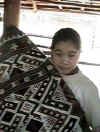
Handwoven textiles on sale in local markets, Vientiane
and Luang

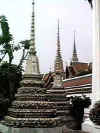
Temple monuments to the Buddha called "stupa"
in Sanskrit

Homage to the loom", marble
wat, Bangkok, Thailand
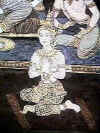
Sita is the splendidly attired,
virtuous queen and heroine of the Hindu epic "The Ramayana",
which entered Thailand, along with other cultural influences from
the Indian subcontinent via trade; In Thailand the story is called
"Ramakien," and it is profusely illustrated in bas-relief
sculptures and wall paintings from this temple (Wat Po) in Bangkok.

Bronze drums in Shanghai Art Museum with bands of textile-like
decoration on sides


Drawing of drum patterns

Head of monumental reclining Buddha, Bangkok, Thailand

Temple mural showing Buddha protected by a supernatural
snake guardian
Notice the flame like "hood"
above the snake's head

Nak design on silk textile

Religious mural painting showing
a Northern Thai woman weaving as part of pastoral scene in the Buddha’s
life

Modern Laotian village woman weaving
.

String type vertical heddle system, very much like pre-jacquard

Vertical heddle system using bamboo
sticks in use above warp and below for storage of pattern. Each stick
or string represents one pick of the pattern.

Independent warp wrapped on warp board anchored
to back of frame loom, Northern Thailand
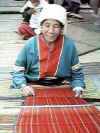
Back strap loom in use, Chiang
mai, Thailand, hill tribe village

open warp, with beater and heddle stick, backstrap loom

Patricia Naenna at her textile
gallery outside of Chiang Mai, Thailand
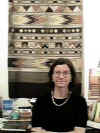
Carol Cassidy at her weaving workshop
and showroom in Vientiane, Laos
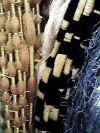
Silk warp bound and dyed for Ikat
textile, Carol Cassidy's workshop yarns

On-loom manipulation of ikat dyed
weft during weaving, Carol Cassidy's Workshop, Vientiane, Laos
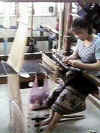
Young Laotian weaver employed by Carol Cassidy's workshop,
Vientiane
Finished weft ikat scarf

Lao Nak design, baby carrier,Laos

Discontinuous weft inlay pattern
in progress
|

